P5.1 Alternating current AQA GCSE Physics P5 Electricity in the home Kerboodle Answers: Page No. 65
1 a Correct potential difference of car battery is 12V
b Correct potential difference of the mains voltage is 325V
c ) Correct potential difference of a torch cell is 1.5V
D Correct potential difference of the maximum potential of the live wire is 230V
2 a If the frequency of the a.c supply was increased without changing the peak potential difference, The trace on the screen in Figure 2 change as follows Increase the number of cycles you see on the screen.so the waves on the screen get squashed together.
b If the frequency of the a.c supply was reduced and the peak potential difference was doubled then there will be decrease in the number of cycles you see on the screen and the waves become more taller by double the peak potential difference.
3 The frequency in Figure 2 if one cycle measures 8cm across the screen for a time base setting of 10 milliseconds per centimetre : Frequency = 1/0.08*0.01 = 1250Hz
4 a An alternating current differs from a direct current as alternating current contain cycle with positive and negative half instead of direct current.
b I Figure 3 showing a diode and a resistor in series with each other and connected to an a.c. supply ,the current in the circuit is a direct current, not an alternating current because diode in the circuit convert alternating current into direct current.
P5.2 Cables and plugs AQA GCSE Physics P5 Electricity in the Home Kerboodle Answers: Page No. 67
1 a The colour of each of the three wires in a mains plug is Brown,yellow or green,blue.
b i Sockets are wired in parallel with each other because when appliances are connected in a parallel arrangement, each of them can be put on and off independently. This is a feature that is essential in a house’s wiring. Also, if the appliances were wired in series, the potential difference across each appliance would vary depending on the resistance of the appliance.
ii Brass, an alloy of copper and zinc, is better than copper for the pins of a three-pin plug because the pins are made of brass because brass is a good conductor and doesn’t rust or oxidize. Copper isn’t as hard as brass even though it conducts better.
iii Cables that are worn away or damaged are dangerous because If someone touches a live wire, a big potential difference will act across their body, causing a current to flow through them. They will suffer an electric shock, which could be lethal.
2 a Cable insulation C rubber
Case D stiff plastic
Pin A brass
Wire B copper
b Choice of material for each part in a; are made of brass because brass is good conductor and doesn’t rust or oxidize. Cases are made of stiff plastic materials because case material is an electrical insulator. The inside of the case is shaped so that the wires and the pins can’t touch each other when the plug is sealed. Copper is used of the wires because it is a good electrical conductor and it bends easily. Cables of different thickness are used for different purpose. This stops the heating effect of the current making the wires too hot.
3 a Each of the three wires in a three-core mains cable is insulated as the main electricity cable contains two or three inner wires. Each has a core of copper, because copper is a good conductor of electricity. The outer layers are flexible plastic, because plastic is a good electrical insulators.
b The metal case of an electrical appliance is connected to earth because the metal case of an electrical appliance is connected to earth because this stops the metal case becoming live if the live wire breaks and touches the case. If the case did become live and touched it, you would be electrocuted.
4 a The cables joining the wall sockets in a house need to be thicker than the cables joining the light fittings because more current passes along wall socket cables than along lighting circuits, so the wires in them have to be much thicker so they have less resistance. This stops the heating effect of the current making the wires too hot.
b Difference between a two-core cable and a three-core cable is that , Three Core has Got an Earth Wire in it, Two core is only Live & Neutral.Two-core cables are used for appliances that have plastic cases.
c An appliance should have a two-core or a three-core cable because 3 core cable (live, neutral and earth ⏚) is for ‘Class I’ or ‘Single Insulated’ appliances which must have an earth connection.
2 core cable (live and neutral) for ‘Class II’ or ‘Double Insulated’ appliances which do not require an earth connection.
P5.3 Electrical power and potential difference AQA GCSE Physics P5 Electricity in thehome Kerboodle Answers: Page No. 69
1 a The human heart transfers about 30000J of energy in about 8 hours. Order of magnitude the power of the human heart
= 30000/8 = 3750J/hour.
b The power supplied To a 5A,230Ve earic heater then power supplied = 230*5 = 1150W
c A 13A fuse would be unsuitable for a 230V, 100W table lamp because the Power = 13*230 = 2990W so the power exceeded from 100W
2 a I The power supplied a12V, 5A light bulb in normal use is Power supplied = 12*5 = 60W
II The power supplied 230V, 12 A heater in normal use is t = 50/12 = 4.16A so we require 5A or 13A current for heater.
II Current = 750/230 = 3.26A so we require 5A or 13A current for microwave oven.
3 a A 3A fuse would be unsuitable for a 230V, 800W microwave oven because the current needed = 800/230 = 3.48A which is greater than 3A.
b i The heating element of a 12V heater has a resistance of 4.0fl. When the heating element is connected to a 12V power supply, the current through it Current through it = 12/4 = 3A.
ii The heating element of a 12V heater has a resistance of 4.0fl. When the heating element is connected to a 12V power supply, Electrical power supplied = 3*12 = 36
ill The heating element of a 12V heater has a resistance of 4.0fl. When the heating element is connected to a 12V power supply, Energy = 36*20*60 = 43200J.
4 a A 6.0 kW electric oven is connected to a fuse box by a cable of resistance 0.25fl. When the cooker is switched on at full power, a current of 26A passes through it; the potential difference between the two ends of the cable = 26*0.25 = 6.5V.
II The power wasted in the cable because of the heating effect of the current = 26*6.5 = 169W.
b Percentage of the power supplied to the oven and the cable is wasted in the cable = 6000/160*100 = 3550.30W
P5.4 Electrical currents and energy transfer AQA GCSE Physics P5 Electricity in the home Kerboodle Answers: Page No. 73
1 a The charge flowing in 50s when the current is 3A = 50*3 = 150C
b The energy transferred when the charge flow is 30C and the potential difference is 4V; Using the equation E= V x Q gives: energy transferred = 4V x 30C = 120J
c The energy transferred in 60s when a current of 0.5 A passes through a 12 ohm resistor = 0.5*0.5*12*60 = 180J.
2 a i the charge flow for a current of 4A for 20s = 20*4 = 80C.
ii Charge flow for a current of 0.2 A for 60 minutes= 0.2*60*60 = 720C.
b The energy transferred to a component is E when for a charge flow of 20C when the potential difference is 6.0V = V x Q = 6*20 = 120J.
ii For a current of 3A that passes through a resistor for 20s, when The potential difference is 5V; the energy transferred to a component is E = P x t = 5*3*20 = 300J.
3 In Figure 2, an ammeter is connected in the circuit In series with the battery. The variable resistor is then adjusted until the ammeter reading is 2.0 A. Charge the charge that passes through the battery in 60s = I*t = 2*60 = 120C
b Potential difference when the energy transferred to or from each coulomb of charge when it passes through each component including the battery (V) = 9V
Charge (Q) = 1C
Energy = total work done (W) = Q x V = 1×9 = 9 joule.
4 a In Figure 3 a 4.0nresistor and an 8,0flresistor in series with each other are connected to a 6,0V battery. The resistance of the two resistors in series is
R = R1 + R2 = 4+8 = 12ohm.
b the current through the resistors = V/R = 6/12 = 0.5A
c the potential difference across each resistor V = 0.5*4 = 2V across 4ohm resistor.
V = 0.5*8 = 4V across 8ohm resistor.
d The energy transferred to each resistor in 60 seconds = 2*0.5*60 = 60joule across 4ohm resistor.
The energy transferred = 4*0.5*60 = 120joule
e Energy supplied by the battery = 0.5*0.5*12*60 = 21joule.
P5.5 Appliances and efficiency AQA GCSE Physics P5 Electricity in the home Kerboodle Answers: Page No. 73
1 i Energy used by a 5 W torch lamp in 50 minutes = 5*3000 = 15000joules.
ii a Energy used by a 100W lamp in 24 hours = 100*1440 = 144000joules.
b Energy used by a 3 kilowatt electric kettle is used six times for 5 minutes each time = 5*3000 = 15000joules 3000*5*60 = 900000joule.
ii Energy used by a 1000 watt microwave oven is used for 30 minutes = 1000*30*60 = 1800000joules.
2 a i Energy is wasted in 1 second by the filament lamp when Efficiency as a ratio =20%/100=0.20 output power = efficiency x input power = 0.20 x 100W =20W
energy wasted per second =100W-20W=80W.
ii By the CFL bulb as Efficiency as a ratio =80%/100=0.80 output power = efficiency x input power = 0.80 x 25W = 20W
energy wasted per second =25W-20W=5W.
b A student looks at Table 1 and claims that 50 LEDs would be needed to give the same output as the haiogen bulb. This claim is incorrect because the efficiency as a ratio =90%/100=0.90 output power = efficiency x input power = 0.90 x 2W = 1.8W for led.
Efficiency as a ratio =25%/100=0.25 output power = efficiency x input power = 0.25 x 100W = 25W for halogen lamp.
So number of led needed = 25/1.8 = 13.888 so we require at least 14 led.
3 a An electric heater is left on for 4 hours. During this time it uses 36 MJ of energy. The power of the heater= 36/4 = 9MJ/hour.
b it would take 36MJ/2000W = 18000secods for a 2000 W electric kettle to use 36 MJ of energy
4 a the mains power supply of a computer provides a current of 15 A at 230V. The power supplied to the computer = 15*230 = 3450W.
b In one month, the computer is used for 130 hours, joules of energy are supplied to the computer in this time is = 3450*130*60 = 26910KJ.
Summary questions AQA GCSE Physics P5 electricity in the home kerboodle Answer Page No. 74
1 a i The wire that is earthed at local substation is neutral one.
ii The wire that alternates in potential is the live wire.
B Anosdlloscope is used to display the potential difference of an alternating potential difference supply unit. When the potential difference changes the waves become taller because of the increase in amplitude.
ii When the frequency is increased the waves faster together because the time for each cycle is less
2 a A mains appliance with a metal case is unsafe if the case is not earthed because in any case live wire touches the metal case, It will become live anyone touching the case electrocuted because of the reason that electric current permits through their body to earth.
b The color of live wire is brown; the color of neutral wire is blue and the color of the earth wire is green and yellow
3 a The wall sockets in a room are connected in parallel with each other because if any appliance connected to socket can be switched on or off without affecting any electric appliance connected to a other wall socket.
b A fuse in the mains plug of an appliance is connected in series with the appliance because in case of short circuit etc., if large amount of current passes through the fuse ,it melts .
4 a i The current in a 230V, 2.5 kW electric kettle is 2500 W/230 V = 11 A
ii We use a 13 A fuse to fit in the kettle.
iii If the kettle is used on average six times a day for 5 minutes each time, the energy in kWh it uses in 28 days is 2500 W × (6 × 5 × 28) = 2.1 Mj
b A student uses a 4.0 A, 230V microwave oven for 10 minutes every day, and a 2500W electric kettle three times a day for 4 minutes each time as power consumed by kettle is more than twice power of oven. Kettle is used less in a day.
c The electric kettle takes 300s TO heat 1.5 kg of water from 15°Cto 100°C so the energy efficiency of the kettle in 300 s = 2500 W × 300 s = 750 000 J
energy of water = 1.5 kg × 4200 J/kg °C × (100 – 15) °C = 540 000 J
1% efficiency = (540 000 J )/750 000 J x 100% = 71%
5 A circuit diagram with 5 Ω resistor in series with bulb, switch and 12 V battery
b i The switch is closed for 60 seconds, a direct current of0.6A passes through the resistor then the energy supplied is 0.6 A × 60 s × 12 V = 432 J
ii the energy transferred to the resistor W = (0.6 A)2 × 5 Ω = 1.8 W E = 1.8 W × 60 s = 108 J
Ill the energy transferred to the bulb is 432 J − 108 J = 324 J
c I the total resistance of the two resistors 5 Ω + 25 Ω = 30 Ω
II the current in the battery is 12 V/30 Ω = 0.40 A
Iii the power supplied by the battery and the power delivered to each resistor is calculated as follows
The battery power is = 0.40 A ´ 12 V = 4.8 W
Now, power to 5 Ω resistor = I2R = 0.402 ´ 5 = 0.80 W
Then, power to 25 Ω resistor = I2R = 0.402 ´ 25 = 4.0 W
6 a the current through the bulb = 36 W/12 V= 3.0 A
ii the charge flow through the bulb in 200s 3.0 A × 200 s = 600 C
b i 7200J of energy is delivered to the bulb in 200s is 36 W × 200 s = 7200 J
ii the energy delivered to the bulb by each coulomb of charge that passes through it is 12 V or 7200 J/600 C = 12 J/C
c i the current through each bulb and through the battery is 3.0 A through each bulb
6.0 A ( = 2 × 3.0 A)
ii When energy per second to each bulb is 36 W which means 36 J/s and energy per second from battery is 12 V × 6.0 A = 72 J/s . So that energy supplied per second to two bulbs is equal to energy supplied per second by the battery
7 a The current needed to supply 6.6 kW of electrical power at 230V is 6600W230 = 28.7 A
b i The electrician must choose D or E cables because maximum safe current through D and E is more than the current when oven works at full power so that the D and E would not swelter.
ii A, B and C overheat when if she chooses thinner conductors because the maximum safe current is less than the oven at full power.
8 An experiment to show that the power supplied to a 12V filament lamp varies with current up to a maximum of 2A. Assuming we have a 12V,2A lamp, an ammeter, a voltmeter, and a variable resistor. Verifying that the meters read zero when the switch is open, after adjusting the variable resistance to the maximum resistance and after closing the switch, first measure the lamp current and p.d. from the ammeter and voltmeter and record the measurements in the table, adjust the variable resistance to increase the current in the phases, at each step repeat and record the measurements, add the third column to the table for the power supplied to the lamp and use the equation P = I × V to calculate the power in each step.
Practice questions AQA GCSE Physics P5 Electricity in the home Page No. 75
01.1 When an electric_current__flows through a wire itis a flow of__electrons ___. In a d.c. circuit the flow is always in___the same direction. In an a,c. circuit the flow is always in____a changing __ direction.
01.2 the peak voltage and frequency of the supply, the Y-gain control is set at 6.5 volts/division and the time base is set at 10 milliseconds/division is 19.5 V and frequency is 12.5 Hz
02.1 The functions of the components of the three pin plug shown in Figure 2. The live wire carries the alternating potential difference from the supply
- the neutral wire completes the circuit
- the earth wire is a safety wire to
- stop the appliance becoming live
- the fuse protects the circuit
- the cable grip stops the wires
- being pulled from the plug
02.2 The fuse in three-pin plug protects the wires from overheating as when the current goes above the fuse rating
- the fuse melts
- and cuts off the current flowing
- in the circuit
02.3 It is important to have an earth wire connected to a metal electric fan as If the live wire touches the metal case, the current will flow to earth
- this causes the fuse to melt and cut off the current.
- this prevents an electric shock
02.4 advantages of using a circuit breaker compared to a fuse is the circuit breaker acts faster than fuse and can be reset
03.1 a variable resistor is used in the circuit to change the potential difference in the circuit
03.2 the resolution of the voltmeter+/- 1 volt
03.3 The potential difference across the resistor is 12V and the current through the resistor is 50 mA. The power of the fixed resistor is 600 mW or 0.6 W
03.4 The resistance of the fixed resistor is 240 Ω
04.1 The frequency of the mains supply is 50 Hz
04.2 Power rating of the toaster is 800 W
04.3 The current in amps flowing through the toaster is 3.48 A
04.4 The fuse of 5 A will be used because slightly above the calculated value of current
04.5 The amount of charge flowing through the toaster if it takes 2.5 minutes to toast two slices of bread is 522 C
05.1 The outer case of the appliance is made of plastic and the wires inside are covered in plastic.
05.2 The gardener may get an electric shock if the cable gets cut whilst using the lawnmower because the live wire is still live with a potential difference of 230 volts the human body is at earth potential difference of 0 volts therefore if the gardener touches the live wire an electric current will flow through him to earth
Disclaimer
Disclaimer: I have tried by level best to provide the answers and video explanations to the best of my knowledge. All the answers and notes are written by me and if there is any similarity in the content then it is purely coincidental. But this is not an alternative to the textbook. You should cover the specification or the textbook thoroughly. This is the quick revision to help you cover the gist of everything. In case you spot any errors then do let us know and we will rectify it. References: BBC Bitesize AQA GCSE Science Kerboodle textbook Wikipedia Wikimedia Commons Join Our Free Facebook Group : Get A* in GCSE and A LEVEL Science and Maths by Mahima Laroyia: https://www.facebook.com/groups/expertguidance.co.uk/ For Free Tips, advice and Maths and Science Help
This page contains the detailed and easy notes for AQA GCSE Physics Electricity for revision and understanding Electricity.
Banner 1
AQA GCSE Paper 1: Complete Revision Summary
ELECTRICITY
Banner 2
4.2 ELECTRICITY
- Circuit Symbols
- Circuit Diagram
- Charge, Current, Resistance and
- Potential Difference
- Voltage-Current Graph of
- Resistor, Filament Bulb and diode
- Series Circuit
- Parallel Circuit
- Main electricity
- Power
- Energy Efficiency
- National Grid
- Static Electricity
CIRCUIT DIAGRAM
- Draw a circuit diagram with a battery, bulb and a switch.
- How will you measure the current and potential Difference of the Circuit ?
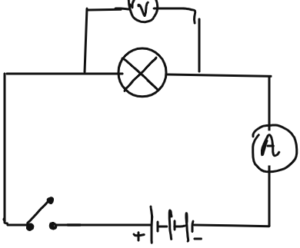
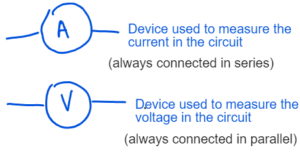
CURRENT, POTENTIAL DIFFERENCE AND RESISTANCE
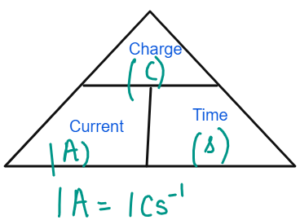
- Current is the rate of flow of charge measured in Ampere.
- One Ampere is the current flowing when one coulomb of charge flows through one second.
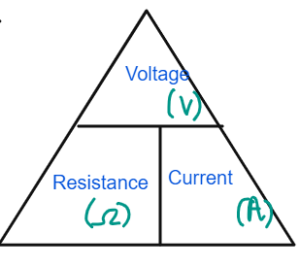
- Resistance is the obstruction to the flow of current measured in ohms
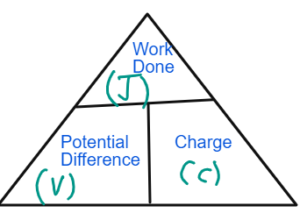
- Potential difference measured in Volts is the work done per unit charge.
- 1V = 1JC-1
- One volts is the potential difference when 1 J of energy is transferred per coulomb of charge.
Banner 3
CIRCUIT SYMBOLS
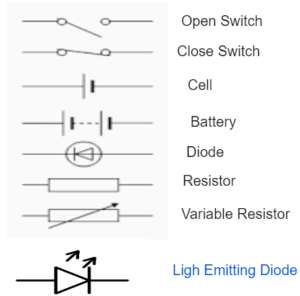
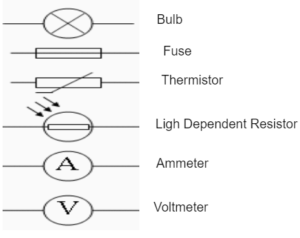
EXAMPLES
Q1 Calculate the current flowing when 4 C of charge flows for 2 minutes ?
I = Q/T = 4/2 X 60 S = 0.033A
Q2 Calculate the energy transferred when 2 V of potential difference creates a charge of 2 C
E = V x Q = 2 x 2 =4J
Q3 Calculate the resistance of the circuit when 4V of potential difference produces a current of 2 A.
R = V/I =4/2 = 2 Ω
Q4 Calculate the charge when 5A of current flows for 5 minutes
Q = I x T = 5 x 5 x 60 =1500C
Q5 Calculate the potential difference when 10 J of work done is done to move the charge of 5 C.
V = E/Q =10/5 = 2V
VOLTAGE-CURRENT GRAPH
Banner 4
Conductor
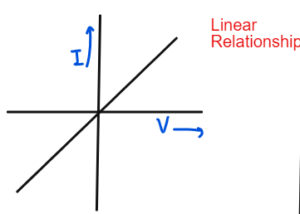
As the voltage increases, the current Increases. The resistance is constant.
Filament Lamp
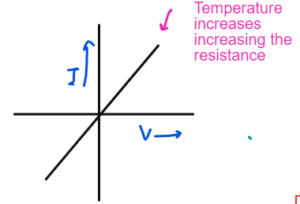
As the voltage increases, the current increases at the start but after that bulb gets heated and increase in temperature increases resistance so the current do not increases and the graph curves.
Diode
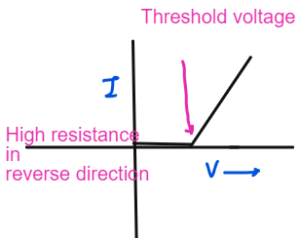
Diode conduct electricity in one direction. In reverse direction, the resistance is too high so no current flows. When it reaches a threshold voltage, the current starts to increases then linearlt.
SERIES AND PARALLEL CIRCUITS
Series Circuit

- Total Resistance is greater than individual: R 1+ R2 = R(Total)
- Current Across each component is the same: V(total)/R(Total)= I
- Voltages get divided between each component
Parallel Circuit

- Total resistance is less than individual = R(total) = R1R2/R1 +R2
- Voltage is same across is each component = V
- Current gets divided between the components
- I1 = V/R1 I2 = V/R2
Banner 5
EXAMPLE OF SERIES AND PARALLEL CIRCUITS
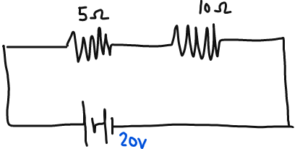
- Total Resistance RI + R2 = 15 Ω
- Voltage: 20V
- Current = 20/15 =1.33A
- Voltage across 5 ohms = 1.33 x 5 = 6.7V
- Voltage across 10 ohms = 1.33 X 10 = 13.3V

- Total Resistance R1R2/ R1 + R2 = 50/15 = 3.33
- Voltage: 20V
- Current = 20/3.33 =6A
- Current across 5 ohms = 20/5 = 4A
- Current across 10 ohms = 20/10 = 2A
MAIN ELECTRCITIY
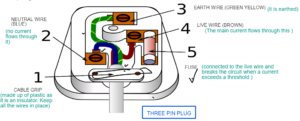
Outer casing is made up of plastic as It is an insulator and Pins are made up of brass as it is a conductor and resistant to corrosion
UK MAIN SUPPLY
Voltage = 230V
Frequency = 50H3
ELECTRIC POWER
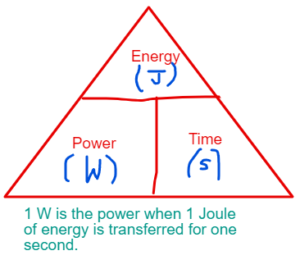
Electrical Power = V x I
(Voltage ) x (Current)
P = I2 x R [V= I x R]
P = V2/R
Q1 Calculate the current product by 200 W bulb if it generate a voltage of 10 v.
P = I x V
200/10 = I = 20
Q2 which is the fuse for this appliance. 12, 20, 23A or 25A
P = V x I
I = P/V = 200/10 = 20A
So the fuse of slightly greater than 20 A will be useful. So it has to be 23 A.
Baneer 6
DIRECT AND ALTERNATING CURRENT
| DIRECT | ALTERNATING |
| Current that flows in one direction. | Current that changes direction. |
| Current in cell and batteries. | Current in the mains supply. |
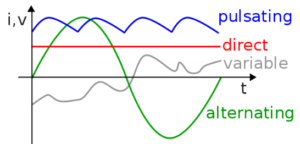
NATIONAL GRID
- A network of cable and transformers that transmits electricity from a power station to homes and buildings.
- Step up transformer is used to increase the voltage for transmission. As higher voltage will have less current and so less loss of energy due to heating effect of current.
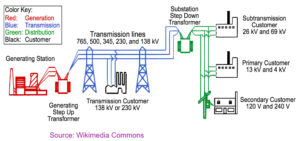
Banner 7
STATIC ELECTRICITY
- Electricity due to the charge produced by rubbing.
- Atom is neutral. Due to rubbing there is a movement of electrons from one surface to another.
- The surface that loose electrons become positively charged and the surface that gains electron become negatively charged.
Banner 8
LIKE CHARGES REPEL and UNLIKE CHARGES ATTRACT EACH OTHER
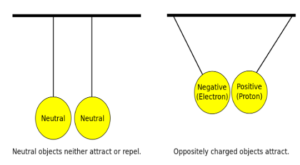
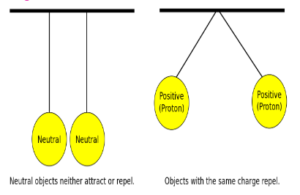
ELECTRIC FIELDS
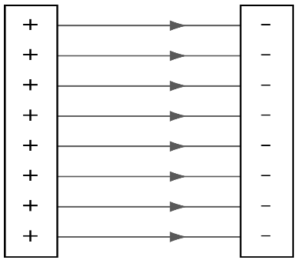
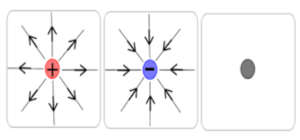
Electric Field of line always travel from positive to negative.
It is the area around a charge object where force of electricity can be felt.
Banner 9
TEST YOUTSELF
Q1 Sketch and explain the Voltage and Current graph of
- a) Resistor
- b) Filament Lamp
- c) Diode

Q2 What are the components of a three pin plug
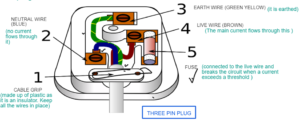
Q3 What is the voltage and frequency of UK Mains Supply ?
UK MAIN SUPPLY
Voltage = 230V
Frequency = 50H3
Q4 How do your calculate efficiency of an appliance
Efficiency = Output Power/ Input Power x 100
Banner 10
Disclaimer:
I have tried my level best to cover the maximum of your specification. But this is not the alternative to the textbook. You should cover the specification or the textbook thoroughly. This is the quick revision to help you cover the gist of everything. In case you spot any errors then do let us know and we will rectify it.
References:
BBC Bitesize
Wikipedia
Wikimedia Commons
Image Source:
Wikipedia
Wikimedia
Commons
Flickr
Pixabay
